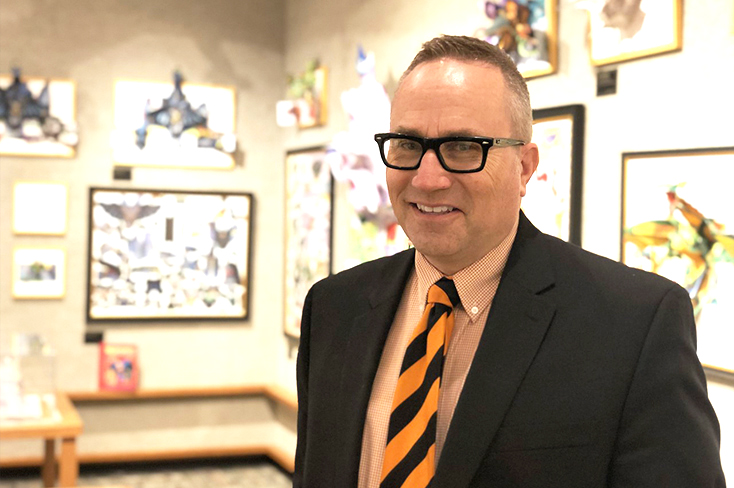In the Right Place: Ben Sapp Knows Past and Future of Mazza Museum
Ben Sapp ’93 M ’95, said that there’s something different about the University of Findlay and its Mazza Museum. There is, he explained, no such thing as a typical day for most here. “You just don’t know who’s going to walk in or the story that will take place because of a work of art or connection with an illustrator. That’s what makes it special. The unknown,” he said.
Sapp, director of University of Findlay’s Mazza Museum, told a story about some sixth graders from Findlay City Schools that were visiting the Mazza during fall break one year, and one particular young man who made an impact that day. “We had Rosemary Wells’ artwork in the gallery at the time,” Sapp recollected, “and this young man would not leave the gallery.” The boy had autism and a great love for Wells, and, Sapp continued, “knew everything there was to know about her, all of her books. I sent her an email and a week later she sent an original work of art autographed to him that we were able to get to him at an all-academic assembly where the student body all stood for him. He took the art and embraced it. That day began as just a Monday. It’s like those signs you see sometimes,” he said. “If you have to ask, you wouldn’t understand. There’s a feeling about the Museum and the University.”
And Sapp would know. Arriving as a freshman student right around thirty years ago, he’s seen UF and the Mazza through many years. It was “that feeling about UF” that got him here as a student in the first place. In the village of Rockford, Ohio, Sapp was involved with sports as a boy and up through high school. When, during his senior year in high school, it was time for the former upperclassmen among his team to come back home for a break from college, Sapp was interested to hear some of them speaking so positively about a college he didn’t know a whole lot about. “They came back and spent a lot of time telling me how much UF meant to them and how happy they were about the decision to attend,” he said. “For me it was something very telling.” So telling, in fact, that Sapp decided to make Findlay his own choice for post-secondary education.
It wasn’t long at Findlay before Sapp met someone who would forever change the trajectory of his life, and who would have nearly everything to do with the position in which he sits now. Like so many young students, Sapp didn’t really know what he wanted to major in when he began his academic career. “I started off as undecided,” he said. “Then I took a course with [late founder and longtime director of the Mazza Museum, Jerry] Mallett. The way he taught, the storytelling, the methods; it made me almost immediately want to major in education.”
On one fateful day, Mallett asked Sapp rather serendipitously if he could stay after class to talk about whether he would be interested in working as a student director for the Mazza Museum. It was a turning point for both men, one that would eventually make an impact that continues to ripple mightily to this day. At the time, the Mazza was in its infancy with, compared to the over fourteen thousand works of art currently housed in the Museum, a fairly scant amount of art taking up residence in the basement of the library. “I loved it, though,” Sapp confessed. “As a student, I found Findlay as a place where any nerves and anxiety were immediately calmed. Very early on, and particularly with the advent of this student-job, I knew it was the right place.”
When it came time for Sapp to graduate, unlike many students who can’t wait to get on with their lives, he felt a pull that caused doubts about what his next step would be. “I absolutely didn’t want to leave after four years. Findlay was, and is, very much home,” he said. The same serendipity came calling once again, however. Sapp said he had an opportunity for a job at graduation, but the Mazza Museum was getting set to open in its current facility in the Virginia B. Gardner Fine Arts Pavilion on campus, and Mallett had applied for a graduate assistantship for the Museum. He asked if Sapp would be interested, “so I stayed in school and worked on my masters of education with emphasis on children’s literature,” Sapp said, during which he “very much got the feeling and hope” that he could stay and eventually be the deputy director of the museum. “And that’s exactly what happened,” he added.
Sapp then saw the Mazza Museum go from art in cases and using Shafer Library’s available times for “opening and closing,” to actual Museum hours, a gift shop, and a library of its own. He became the director of the Museum in 2007, and, while he has witnessed things positively changing exponentially over the years, he realizes things are only going to get better. “When it first started, people came more than anything for the events, and then, through that, saw and appreciated the artwork on display,” he explained. That’s certainly still the case, but what has changed, according to Sapp, is that, through becoming better known and having so much art now, there are people coming every single day, and because of that are able to see campus, the city, and everything else. “That, maybe fifteen years ago, wouldn’t have happened,” he added.
Now, with the addition of the Conda Education STEAM Center and all of the innovation and excitement that goes along with it on the horizon, Sapp said that “it’s all new once again and full of so much potential. What we could be doing in that new space five years from now, we can’t even currently conceive of because of all of the potential technology. And to be able to use art with that? It makes this place very special.”
What’s most special about Mazza and UF, though, Sapp said, is the people. “We absolutely could not do it without our docents, donors, volunteers, and everyone in between,” he explained. “They all have such a love for art and literature and the University itself, and, just as important as that, want to share it with people of all ages.”
Sapp’s son started classes at UF this semester, and, Ben said, is already feeling those same feelings he felt as a freshman. Among them, that certain pride that Sapp and others on campus have of those intangibles that make the days untypical. “It’s no one individual,” he said. “From President Fell on down. All of the work that everyone does creates on this campus and in the Museum a resource for inspiration in people. It truly is a big family.”

